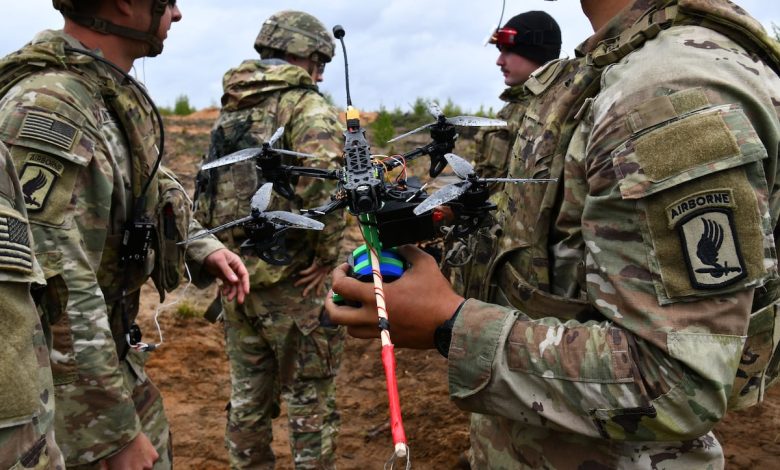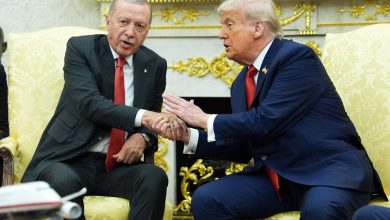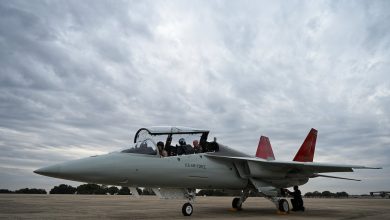Drones could replace large US Army units in Europe, expert suggests

Since 1945, the U.S. Army has been designed to defend Europe. Despite detours into counterinsurgency in Southeast Asia and the Middle East, the core of the Army remains a large force of heavy mechanized brigades.
But the times are changing. The Obama administration shifted American strategic policy from Europe to Asia. Today, the Trump administration is prioritizing homeland defense, the Western Hemisphere and the Pacific. So what do you do with an Army designed for Europe when Europe isn’t the focus anymore?
The answer is drones, says one American expert. An expeditionary force of drone units — stationed in Europe or dispatched as needed — would be an economical alternative to maintaining large garrisons overseas.
“Forward-deployed forces in large garrisons and infantry and armor-centric rotational force packages need to give way to mixed drone units that can be deployed faster and better increase partner combat power,” wrote Benjamin Jensen, director of the Futures Lab at the Center for Strategic and International Studies think tank in Washington, D.C., in a recent analysis.
Jensen envisions a system where NATO’s European members provide traditional combat arms such as tanks and infantry fighting vehicles. They would be backed by American drone units that would provide a mix of strike, reconnaissance and electronic warfare unmanned aerial vehicles.
“Imagine that instead of a 1,000-person battalion, there was a 250-person rotational battalion that has a mix of 500 FPV [first-person view] drones and octocopters,” Jensen told Defense News. “And they’re running missions with those European partners, and they’re able to flow in, operate and then flow out quickly.”
The controversial notion that drones can replace boots on the ground isn’t new. But Jensen sees the key as “substitution,” a concept borrowed from economics in which one product can be replaced by another that offers equivalent value at a lower price. Just as shoppers can replace one brand of canned soup with a cheaper brand if there is a sale at the supermarket, drones can substitute for traditional ground platforms in some cases.
Substituting “more flexible and mobile drone formations can generate options to support U.S. interests in Europe,” wrote Jensen, who has previously proposed creating drone brigades. For example, an Army Launched Effects battalion, equipped with strike, surveillance and electronic warfare drones, could both patrol a wide area and deploy drone swarms to defeat a Russian invasion.
Substitution also applies to designing drones as well.
“If drones can be rapidly reconfigured across different payloads — say, intelligence collection, electronic warfare, and strike — with little friction, then one drone is nearly as good as another that was optimized for the task,” Jensen wrote.
To some extent, the Army is already on this path through the Army Transformation Initiative, which calls for rapid development and fielding of small drones. However, Jensen disagrees with plans to eliminate medium altitude, long endurance, or MALE, drones such as the MQ-1C Gray Eagle.
Yet Jensen counters that MALE drones offer versatility that small drones can’t match.
“I want something that generates enough power and has enough payload coverage that I can cover an area for 24 hours and carry eight-plus Hellfires if I need to,” Jensen said.
While the Army Transformation Initiative emphasizes drones, “what hasn’t received as much attention is how best to realize this vision in the reserve forces,” Jensen wrote. New drone units can be created within the Army Reserve and National Guard, while Army aviation units — some of which are slated to be eliminated — can be repurposed into unmanned aerial vehicle formations. This would minimize costs while offering the ability to quickly mobilize combat power.
And how might NATO feel about America replacing ground forces with drones?
“I think something is better than nothing,” Jensen replied.
A policy of deploying drone-centric expeditionary forces has implications beyond the battlefield. It “has the potential to alter the grammar of deterrence,” Jensen wrote. Instead of trying to deter Russia by regularly stationing an Armored Brigade Combat Team in Poland, mobile drone brigades could be sent to Eastern Europe to demonstrate American support for NATO during a crisis. Drone-based units would also be useful in the Pacific, where long distances put a premium on light, easily transportable formations.
“You can get a lot more interesting payloads, interesting performance and provide yourself a lot more flexibility than to committing to what was really 20th-century deterrence,” Jensen said.







